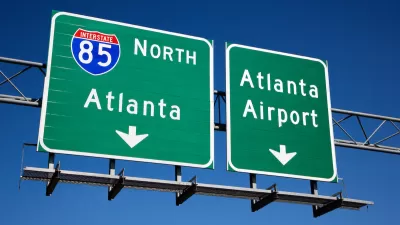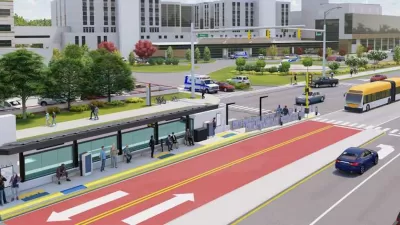Bus rapid transit lines offer a less expensive, quicker-build alternative to rail that can bring other infrastructure improvements with it.

In an article in Governing, Aaron M. Renn makes the case for bus rapid transit (BRT), arguing that the approach is a cost-effective way to improve transit service without the high costs and extensive timelines required to build new rail lines.
BRT offers other advantages, too. “Because they typically run on city streets, BRT systems also offer the chance to perform badly needed street and sewer repairs during construction. Sidewalks can be rebuilt or added. Traffic signals can be replaced, along with new features such as prioritizing buses over auto traffic and additional pedestrian safety measures.”
Renn points to the Red Line in Indianapolis as a successful example of BRT, noting that the entire project cost less than $100 million (whereas an Austin, Texas rail project is expected to cost $500,000 per mile), and the city benefited from a federal grant that funded 80 percent of the project. “That means the local funds essentially went to fix streets that already needed to be repaired, and the city got a BRT line for free, courtesy of the federal government.”
For Renn, BRT is a clear solution for many cities, offering a way to make transit service better and more reliable while making other infrastructure improvements.
FULL STORY: The Bus Lines That Can Solve a Bunch of Urban Problems

Alabama: Trump Terminates Settlements for Black Communities Harmed By Raw Sewage
Trump deemed the landmark civil rights agreement “illegal DEI and environmental justice policy.”

Planetizen Federal Action Tracker
A weekly monitor of how Trump’s orders and actions are impacting planners and planning in America.

Why Should We Subsidize Public Transportation?
Many public transit agencies face financial stress due to rising costs, declining fare revenue, and declining subsidies. Transit advocates must provide a strong business case for increasing public transit funding.

Understanding Road Diets
An explainer from Momentum highlights the advantages of reducing vehicle lanes in favor of more bike, transit, and pedestrian infrastructure.

New California Law Regulates Warehouse Pollution
A new law tightens building and emissions regulations for large distribution warehouses to mitigate air pollution and traffic in surrounding communities.

Phoenix Announces Opening Date for Light Rail Extension
The South Central extension will connect South Phoenix to downtown and other major hubs starting on June 7.
Urban Design for Planners 1: Software Tools
This six-course series explores essential urban design concepts using open source software and equips planners with the tools they need to participate fully in the urban design process.
Planning for Universal Design
Learn the tools for implementing Universal Design in planning regulations.
Caltrans
Smith Gee Studio
Institute for Housing and Urban Development Studies (IHS)
City of Grandview
Harvard GSD Executive Education
Toledo-Lucas County Plan Commissions
Salt Lake City
NYU Wagner Graduate School of Public Service





























